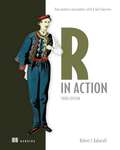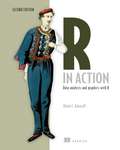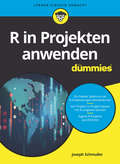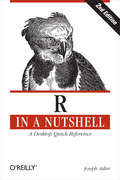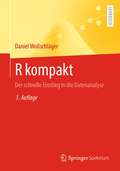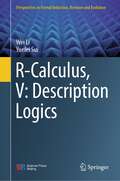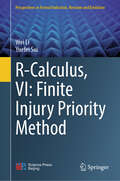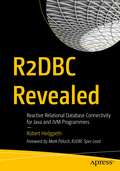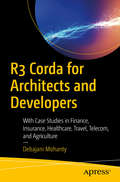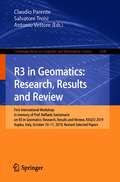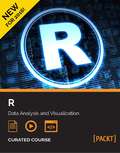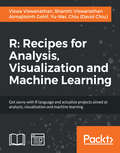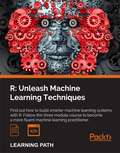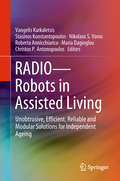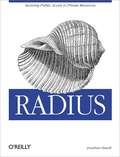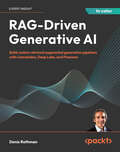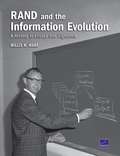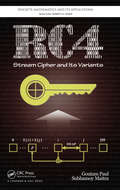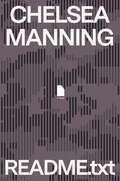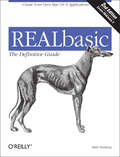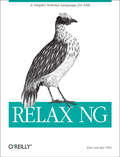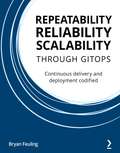- Table View
- List View
R in Action, Third Edition: Data analysis and graphics with R and Tidyverse
by Robert I. KabacoffR is the most powerful tool you can use for statistical analysis. This definitive guide smooths R&’s steep learning curve with practical solutions and real-world applications for commercial environments.In R in Action, Third Edition you will learn how to: Set up and install R and RStudio Clean, manage, and analyze data with R Use the ggplot2 package for graphs and visualizations Solve data management problems using R functions Fit and interpret regression models Test hypotheses and estimate confidence Simplify complex multivariate data with principal components and exploratory factor analysis Make predictions using time series forecasting Create dynamic reports and stunning visualizations Techniques for debugging programs and creating packages R in Action, Third Edition makes learning R quick and easy. That&’s why thousands of data scientists have chosen this guide to help them master the powerful language. Far from being a dry academic tome, every example you&’ll encounter in this book is relevant to scientific and business developers, and helps you solve common data challenges. R expert Rob Kabacoff takes you on a crash course in statistics, from dealing with messy and incomplete data to creating stunning visualizations. This revised and expanded third edition contains fresh coverage of the new tidyverse approach to data analysis and R&’s state-of-the-art graphing capabilities with the ggplot2 package. About the technology Used daily by data scientists, researchers, and quants of all types, R is the gold standard for statistical data analysis. This free and open source language includes packages for everything from advanced data visualization to deep learning. Instantly comfortable for mathematically minded users, R easily handles practical problems without forcing you to think like a software engineer. About the book R in Action, Third Edition teaches you how to do statistical analysis and data visualization using R and its popular tidyverse packages. In it, you&’ll investigate real-world data challenges, including forecasting, data mining, and dynamic report writing. This revised third edition adds new coverage for graphing with ggplot2, along with examples for machine learning topics like clustering, classification, and time series analysis. What's inside Clean, manage, and analyze data Use the ggplot2 package for graphs and visualizations Techniques for debugging programs and creating packages A complete learning resource for R and tidyverse About the reader Requires basic math and statistics. No prior experience with R needed. About the author Dr. Robert I Kabacoff is a professor of quantitative analytics at Wesleyan University and a seasoned data scientist with more than 20 years of experience. Table of Contents PART 1 GETTING STARTED 1 Introduction to R 2 Creating a dataset 3 Basic data management 4 Getting started with graphs 5 Advanced data management PART 2 BASIC METHODS 6 Basic graphs 7 Basic statistics PART 3 INTERMEDIATE METHODS 8 Regression 9 Analysis of variance 10 Power analysis 11 Intermediate graphs 12 Resampling statistics and bootstrapping PART 4 ADVANCED METHODS 13 Generalized linear models 14 Principal components and factor analysis 15 Time series 16 Cluster analysis 17 Classification 18 Advanced methods for missing data PART 5 EXPANDING YOUR SKILLS 19 Advanced graphs 20 Advanced programming 21 Creating dynamic reports 22 Creating a package
R in Action: Data analysis and graphics with R
by Robert I. KabacoffSummaryR in Action, Second Edition presents both the R language and the examples that make it so useful for business developers. Focusing on practical solutions, the book offers a crash course in statistics and covers elegant methods for dealing with messy and incomplete data that are difficult to analyze using traditional methods. You'll also master R's extensive graphical capabilities for exploring and presenting data visually. And this expanded second edition includes new chapters on time series analysis, cluster analysis, and classification methodologies, including decision trees, random forests, and support vector machines.Purchase of the print book includes a free eBook in PDF, Kindle, and ePub formats from Manning Publications.About the TechnologyBusiness pros and researchers thrive on data, and R speaks the language of data analysis. R is a powerful programming language for statistical computing. Unlike general-purpose tools, R provides thousands of modules for solving just about any data-crunching or presentation challenge you're likely to face. R runs on all important platforms and is used by thousands of major corporations and institutions worldwide.About the BookR in Action, Second Edition teaches you how to use the R language by presenting examples relevant to scientific, technical, and business developers. Focusing on practical solutions, the book offers a crash course in statistics, including elegant methods for dealing with messy and incomplete data. You'll also master R's extensive graphical capabilities for exploring and presenting data visually. And this expanded second edition includes new chapters on forecasting, data mining, and dynamic report writing.What's InsideComplete R language tutorialUsing R to manage, analyze, and visualize dataTechniques for debugging programs and creating packagesOOP in ROver 160 graphsAbout the AuthorDr. Rob Kabacoff is a seasoned researcher and teacher who specializes in data analysis. He also maintains the popular Quick-R website at statmethods.net.Table of ContentsPART 1 GETTING STARTEDIntroduction to RCreating a datasetGetting started with graphsBasic data managementAdvanced data managementPART 2 BASIC METHODSBasic graphsBasic statisticsPART 3 INTERMEDIATE METHODSRegressionAnalysis of variancePower analysisIntermediate graphsResampling statistics and bootstrappingPART 4 ADVANCED METHODSGeneralized linear modelsPrincipal components and factor analysisTime seriesCluster analysisClassificationAdvanced methods for missing dataPART 5 EXPANDING YOUR SKILLSAdvanced graphics with ggplot2Advanced programmingCreating a packageCreating dynamic reportsAdvanced graphics with the lattice package available online only from manning.com/kabacoff2
R in Projekten anwenden für Dummies (Für Dummies)
by Joseph SchmullerDieses Buch bietet einen einzigartigen Learning-by-Doing-Ansatz. Sie werden Ihre R-Fähigkeiten erweitern und vertiefen, indem Sie eine Vielzahl von Beispielprojekten aus der Praxis nachvollziehen. Erlernen Sie die Grundlagen von R und RStudio sowie Möglichkeiten der Datenreduktion, des Mapping und der Bildverarbeitung. Dabei kommen Werkzeuge zum Einsatz, die Daten grafisch auswerten, die Analyse interaktiv machen oder die maschinelles Lernen einsetzen. Und auf dem Weg dahin können Sie sogar Ihr Statistikwissen noch erweitern. Warum sollten Sie das Rad neu erfinden, wenn es schon fertige R-Pakete gibt, die Ihre Bedürfnisse bedienen? Hier lernen Sie sie kennen.
R in a Nutshell: A Desktop Quick Reference
by Joseph AdlerIf you’re considering R for statistical computing and data visualization, this book provides a quick and practical guide to just about everything you can do with the open source R language and software environment. You’ll learn how to write R functions and use R packages to help you prepare, visualize, and analyze data. Author Joseph Adler illustrates each process with a wealth of examples from medicine, business, and sports.Updated for R 2.14 and 2.15, this second edition includes new and expanded chapters on R performance, the ggplot2 data visualization package, and parallel R computing with Hadoop.Get started quickly with an R tutorial and hundreds of examplesExplore R syntax, objects, and other language detailsFind thousands of user-contributed R packages online, including BioconductorLearn how to use R to prepare data for analysisVisualize your data with R’s graphics, lattice, and ggplot2 packagesUse R to calculate statistical fests, fit models, and compute probability distributionsSpeed up intensive computations by writing parallel R programs for HadoopGet a complete desktop reference to R
R kompakt: Der schnelle Einstieg in die Datenanalyse
by Daniel WollschlägerDieses Buch bietet eine kompakte Einführung in die Datenauswertung mit der freien Statistikumgebung R. Ziel ist es dabei, einen Überblick über die Funktionalität von R zu liefern und einen schnellen Einstieg in die deskriptive Datenauswertung sowie in die Umsetzung der wichtigsten statistischen Tests zu ermöglichen. Zudem deckt das Buch die vielfältigen Möglichkeiten ab, Diagramme zu erstellen, Daten mit anderen Programmen auszutauschen und R durch Zusatzpakete zu erweitern. Das Buch ist damit für Leser geeignet, die R kennenlernen und rasch in konkreten Aufgabenstellungen einsetzen möchten.Für die 3. Auflage wurde das Buch grundlegend überarbeitet und auf Neuerungen der R Version 4.1.0 sowie der aktuellen Landschaft der Zusatzpakete abgestimmt. Mit einer stärkeren Ausrichtung auf Data Science Anwendungen stellt das Buch nun ausführlich die Pakete dplyr zur Datenaufbereitung und ggplot2 für Diagramme vor. Darüber hinaus enthält das Buch eine Darstellung von dynamischen R Markdown Dokumenten zur Unterstützung reproduzierbarer Auswertungen.
R-Calculus, V: Description Logics (Perspectives in Formal Induction, Revision and Evolution)
by Wei Li Yuefei SuiThis book series consists of two parts, decidable description logics and undecidable description logics. It gives the R-calculi for description logics. This book offers a rich blend of theory and practice. It is suitable for students, researchers and practitioners in the field of logic.
R-Calculus, VI: Finite Injury Priority Method (Perspectives in Formal Induction, Revision and Evolution)
by Wei Li Yuefei SuiThis sixth volume of the book series applies finite injury priority method to R-calculi and obtain (in)completeness theorem for binary-valued, Post three-valued, B2^2-valued and L4-valued first-order logics, and extend the method to infinite injury priority method and 0"-method for default logic to produce pseudo-extensions of a default theory, corresponding to different R-calculi. Finite injury priority method and tree constructions are discussed in this book. This book offers a rich blend of theory and practice. It is suitable for students, researchers and practitioners in the field of logic.
R2DBC Revealed: Reactive Relational Database Connectivity for Java and JVM Programmers
by Robert HedgpethUnderstand the newest trend in database programming for developers working in Java, Kotlin, Clojure, and other JVM-based languages. This book introduces Reactive Relational Database Connectivity (R2DBC), a modern way of connecting to and querying relational databases from Java and other JVM languages. The book begins by helping you understand not only what reactive programming is, but why it is necessary. Then building on those fundamentals, the book takes you into the world of databases and the newly released Reactive Relational Database Connectivity (R2DBC) specification. Examples in the book are worked using the freely available MariaDB database along with MariaDB’s vendor-implementation of the R2DBC service-provider interface (SPI). Following along with the examples and the provided example code helps prepare you to work with any of the growing number of R2DBC implementations for popular enterprise databases such as Oracle Database and SQL Server. You’ll be well prepared for what is becoming the future of database access from Java and other languages built on the JVM.What You Will LearnUnderstand why R2DBC was created and how it utilizes the Reactive Streams API Understand the components of the R2DBC service-provider interfaceCreate and manage reactive database connections and connection pools using an R2DBC clientProgrammatically execute queries on a relational database using an R2DBC clientEffectively utilize transactions using an R2DBC clientBuild relational database-driven applications that are event-driven and non-blockingWho This Book Is ForSoftware developers building solutions using JVM languages and the JVM ecosystem, and developers who need an introduction to the R2DBC specification and reactive programming with relational databases and want to understand what Reactive Relational Database Connectivity is and why it came about. This book includes practical examples of using the R2DBC specification with Java and MariaDB that will provide developers with the knowledge they need to create their own solutions.
R3 Corda for Architects and Developers: With Case Studies in Finance, Insurance, Healthcare, Travel, Telecom, and Agriculture
by Debajani MohantyExplore the entire R3 Corda ecosystem using theory, labs, and use cases. This book introduces distributed ledger technology, Corda architecture, and smart contract programming in Java, guiding you through testing and deployment. Further, you will explore various business problems in finance, insurance, healthcare, travel, and agriculture and discover how Corda can solve these issues through its unique and efficient distributed ledger technology. These business scenarios come with flowcharts, diagrams, and sample code that stakeholders can refer to and further enhance during live projects. After reading R3 Corda for Architects and Developers, you will understand how efficient usage of Corda can create value for your business processes by making business intelligence more readily available, user friendly, and interactive. What You Will Learn Work with distributed ledger technologyDiscover Corda’s differentiators Develop smart contracts, states, and business flows on Corda Take advantage of Corda in your business by going through case studies in various domains Who This Book Is For Blockchain developers and architects who wish to learn Corda.
R3 in Geomatics: First International Workshop in memory of Prof. Raffaele Santamaria on R3 in Geomatics: Research, Results and Review, R3GEO 2019, Naples, Italy, October 10–11, 2019, Revised Selected Papers (Communications in Computer and Information Science #1246)
by Claudio Parente Salvatore Troisi Antonio VettoreThis book constitutes the refereed proceedings of the First International Workshop in memory of Prof. Raffaele Santamaria on R3 in Geomatics: Research, Results and Review, R3GEO 2019, held in Naples, Italy*, in October 2019.The 27 full papers along with the 2 short papers presented were carefully reviewed and selected from 39 submissions. The papers are organized in topical sections on: GNSS and geodesy; photogrammetry and laser scanning; GIS and remote sensing.
R: Data Analysis and Visualization
by Brett Lantz Edina Berlinger Gergely Daroczi Jaynal Abedin Hrishi V. Mittal Bater Makhabel Tony Fischetti Ferenc Illes Adam Banai Milan Badics Balázs Árpád Szucs Dániel Havran Julia Molnár Péter Juhász István Margitai Tamás Vadász Barbara Dömötör Kata Váradi Ágnes Tuza Ágnes Vidovics-Dancs Balázs Márkus Péter Medvegyev Gergely GablerMaster the art of building analytical models using R About This Book * Load, wrangle, and analyze your data using the world's most powerful statistical programming language * Build and customize publication-quality visualizations of powerful and stunning R graphs * Develop key skills and techniques with R to create and customize data mining algorithms * Use R to optimize your trading strategy and build up your own risk management system * Discover how to build machine learning algorithms, prepare data, and dig deep into data prediction techniques with R Who This Book Is For This course is for data scientist or quantitative analyst who are looking at learning R and take advantage of its powerful analytical design framework. It's a seamless journey in becoming a full-stack R developer What You Will Learn * Describe and visualize the behavior of data and relationships between data * Gain a thorough understanding of statistical reasoning and sampling * Handle missing data gracefully using multiple imputation * Create diverse types of bar charts using the default R functions * Produce and customize density plots and histograms with lattice and ggplot2 * Get to know the top classification algorithms written in R * Familiarize yourself with algorithms written in R for spatial data mining, text mining, and so on * Understand relationships between market factors and their impact on your portfolio * Harness the power of R to build machine learning algorithms with real-world data science applications * Learn specialized machine learning techniques for text mining, big data, and more In Detail The R learning path created for you has five connected modules,which are a mini-course in their own right.As you complete each one, you'll have gained key skills and be ready for the material in the next module! This course begins by looking at the Data Analysis with R module. This will help you navigate the R environment. You'll gain a thorough understanding of statistical reasoning and sampling. Finally, you'll be able to put best practices into effect to make your job easier and facilitate reproducibility. The second place to explore is R Graphs,which will help you leverage powerful default R graphics and utilize advanced graphics systems such as lattice and ggplot2, the grammar of graphics. Through inspecting large datasets using tableplot and stunning 3D visualizations, you will know how to produce, customize, and publish advanced visualizations using this popular and powerful framework. With the third module, Learning Data Mining with R, you will learn how to manipulate data with R using code snippets and be introduced to mining frequent patterns, association, and correlations while working with R programs. You will finish this module feeling confident in your ability to know which data mining algorithm to apply in any situation. The Mastering R for Quantitative Finance module pragmatically introduces both the quantitative finance concepts and their modeling in R, enabling you to build a tailor-made trading system on your own. By the end of the module, you will be well-versed with various financial techniques using R and will be able to place good bets while making financial decisions. Finally, we'll look at the Machine Learning with R module. With this module, you'll discover all the analytical tools you need to gain insights from complex data and learn how to choose the correct algorithm for your specific needs. You'll also learn to apply machine learning methods to deal with common tasks, including classification, prediction, forecasting, market analysis, and clustering. Style and approach Learn data analysis, data visualization techniques, data mining, and machine learning all using R and also learn to build models in quantitative finance using this powerful language
R: Recipes for Analysis, Visualization and Machine Learning
by Atmajitsinh Gohil Yu-Wei Chiu Shanthi Viswanathan Viswa ViswanathanGet savvy with R language and actualize projects aimed at analysis, visualization and machine learning About This Book * Proficiently analyze data and apply machine learning techniques * Generate visualizations, develop interactive visualizations and applications to understand various data exploratory functions in R * Construct a predictive model by using a variety of machine learning packages Who This Book Is For This Learning Path is ideal for those who have been exposed to R, but have not used it extensively yet. It covers the basics of using R and is written for new and intermediate R users interested in learning. This Learning Path also provides in-depth insights into professional techniques for analysis, visualization, and machine learning with R - it will help you increase your R expertise, regardless of your level of experience. What You Will Learn * Get data into your R environment and prepare it for analysis * Perform exploratory data analyses and generate meaningful visualizations of the data * Generate various plots in R using the basic R plotting techniques * Create presentations and learn the basics of creating apps in R for your audience * Create and inspect the transaction dataset, performing association analysis with the Apriori algorithm * Visualize associations in various graph formats and find frequent itemset using the ECLAT algorithm * Build, tune, and evaluate predictive models with different machine learning packages * Incorporate R and Hadoop to solve machine learning problems on big data In Detail The R language is a powerful, open source, functional programming language. At its core, R is a statistical programming language that provides impressive tools to analyze data and create high-level graphics. This Learning Path is chock-full of recipes. Literally! It aims to excite you with awesome projects focused on analysis, visualization, and machine learning. We'll start off with data analysis - this will show you ways to use R to generate professional analysis reports. We'll then move on to visualizing our data - this provides you with all the guidance needed to get comfortable with data visualization with R. Finally, we'll move into the world of machine learning - this introduces you to data classification, regression, clustering, association rule mining, and dimension reduction. This Learning Path combines some of the best that Packt has to offer in one complete, curated package. It includes content from the following Packt products: * R Data Analysis Cookbook by Viswa Viswanathan and Shanthi Viswanathan * R Data Visualization Cookbook by Atmajitsinh Gohil * Machine Learning with R Cookbook by Yu-Wei, Chiu (David Chiu) Style and approach This course creates a smooth learning path that will teach you how to analyze data and create stunning visualizations. The step-by-step instructions provided for each recipe in this comprehensive Learning Path will show you how to create machine learning projects with R.
R: Unleash Machine Learning Techniques
by Brett Lantz Raghav Bali Dipanjan Sarkar Cory LesmeisterFind out how to build smarter machine learning systems with R. Follow this three module course to become a more fluent machine learning practitioner. About This Book * Build your confidence with R and find out how to solve a huge range of data-related problems * Get to grips with some of the most important machine learning techniques being used by data scientists and analysts across industries today * Don't just learn - apply your knowledge by following featured practical projects covering everything from financial modeling to social media analysis Who This Book Is For Aimed for intermediate-to-advanced people (especially data scientist) who are already into the field of data science What You Will Learn * Get to grips with R techniques to clean and prepare your data for analysis, and visualize your results * Implement R machine learning algorithms from scratch and be amazed to see the algorithms in action * Solve interesting real-world problems using machine learning and R as the journey unfolds * Write reusable code and build complete machine learning systems from the ground up * Learn specialized machine learning techniques for text mining, social network data, big data, and more * Discover the different types of machine learning models and learn which is best to meet your data needs and solve your analysis problems * Evaluate and improve the performance of machine learning models * Learn specialized machine learning techniques for text mining, social network data, big data, and more In Detail R is the established language of data analysts and statisticians around the world. And you shouldn't be afraid to use it... This Learning Path will take you through the fundamentals of R and demonstrate how to use the language to solve a diverse range of challenges through machine learning. Accessible yet comprehensive, it provides you with everything you need to become more a more fluent data professional, and more confident with R. In the first module you'll get to grips with the fundamentals of R. This means you'll be taking a look at some of the details of how the language works, before seeing how to put your knowledge into practice to build some simple machine learning projects that could prove useful for a range of real world problems. For the following two modules we'll begin to investigate machine learning algorithms in more detail. To build upon the basics, you'll get to work on three different projects that will test your skills. Covering some of the most important algorithms and featuring some of the most popular R packages, they're all focused on solving real problems in different areas, ranging from finance to social media. This Learning Path has been curated from three Packt products: * R Machine Learning By Example By Raghav Bali, Dipanjan Sarkar * Machine Learning with R Learning - Second Edition By Brett Lantz * Mastering Machine Learning with R By Cory Lesmeister Style and approach This is an enticing learning path that starts from the very basics to gradually pick up pace as the story unfolds. Each concept is first defined in the larger context of things succinctly, followed by a detailed explanation of their application. Each topic is explained with the help of a project that solves a real-world problem involving hands-on work thus giving you a deep insight into the world of machine learning.
RADIO--Robots in Assisted Living: Unobtrusive, Efficient, Reliable and Modular Solutions for Independent Ageing
by Nikolaos S. Voros Christos P. Antonopoulos Vangelis Karkaletsis Stasinos Konstantopoulos Roberta Annicchiarico Maria DagioglouThis book describes a unique approach to bring robotic technology into elders’ daily lives. Low cost components and low cost robotic assistants are effectively combined to offer high quality services to elders and people in need. The book presents in a comprehensive way how technology can be used for developing a new healthcare paradigm where high quality services are offered at home, thus reducing the ever-increasing hospitalization cost of the elders and the people with chronic diseases.
RADIUS: Securing Public Access to Private Resources
by Jonathan HassellThe subject of security never strays far from the minds of IT workers, for good reason. If there is a network with even just one connection to another network, it needs to be secured. RADIUS, or Remote Authentication Dial-In User Service, is a widely deployed protocol that enables companies to authenticate, authorize and account for remote users who want access to a system or service from a central network server. Originally developed for dial-up remote access, RADIUS is now used by virtual private network (VPN) servers, wireless access points, authenticating Ethernet switches, Digital Subscriber Line (DSL) access, and other network access types. Extensible, easy to implement, supported, and actively developed, RADIUS is currently the de facto standard for remote authentication.RADIUS provides a complete, detailed guide to the underpinnings of the RADIUS protocol, with particular emphasis on the utility of user accounting. Author Jonathan Hassell draws from his extensive experience in Internet service provider operations to bring practical suggestions and advice for implementing RADIUS. He also provides instructions for using an open-source variation called FreeRADIUS."RADIUS is an extensible protocol that enjoys the support of a wide range of vendors," says Jonathan Hassell. "Coupled with the amazing efforts of the open source development community to extend RADIUS's capabilities to other applications-Web, calling card security, physical device security, such as RSA's SecureID-RADIUS is possibly the best protocol with which to ensure only the people that need access to a resource indeed gain that access."This unique book covers RADIUS completely, from the history and theory of the architecture around which it was designed, to how the protocol and its ancillaries function on a day-to-day basis, to implementing RADIUS-based security in a variety of corporate and service provider environments. If you are an ISP owner or administrator, corporate IT professional responsible for maintaining mobile user connectivity, or a web presence provider responsible for providing multiple communications resources, you'll want this book to help you master this widely implemented but little understood protocol.
RAG-Driven Generative AI: Build custom retrieval augmented generation pipelines with LlamaIndex, Deep Lake, and Pinecone
by Denis RothmanMinimize AI hallucinations and build accurate, custom generative AI pipelines with RAG using embedded vector databases and integrated human feedback Purchase of the print or Kindle book includes a free eBook in PDF formatKey FeaturesImplement RAG’s traceable outputs, linking each response to its source document to build reliable multimodal conversational agentsDeliver accurate generative AI models in pipelines integrating RAG, real-time human feedback improvements, and knowledge graphsBalance cost and performance between dynamic retrieval datasets and fine-tuning static dataBook DescriptionRAG-Driven Generative AI provides a roadmap for building effective LLM, computer vision, and generative AI systems that balance performance and costs. This book offers a detailed exploration of RAG and how to design, manage, and control multimodal AI pipelines. By connecting outputs to traceable source documents, RAG improves output accuracy and contextual relevance, offering a dynamic approach to managing large volumes of information. This AI book shows you how to build a RAG framework, providing practical knowledge on vector stores, chunking, indexing, and ranking. You’ll discover techniques to optimize your project’s performance and better understand your data, including using adaptive RAG and human feedback to refine retrieval accuracy, balancing RAG with fine-tuning, implementing dynamic RAG to enhance real-time decision-making, and visualizing complex data with knowledge graphs. You’ll be exposed to a hands-on blend of frameworks like LlamaIndex and Deep Lake, vector databases such as Pinecone and Chroma, and models from Hugging Face and OpenAI. By the end of this book, you will have acquired the skills to implement intelligent solutions, keeping you competitive in fields from production to customer service across any project.What you will learnScale RAG pipelines to handle large datasets efficientlyEmploy techniques that minimize hallucinations and ensure accurate responsesImplement indexing techniques to improve AI accuracy with traceable and transparent outputsCustomize and scale RAG-driven generative AI systems across domainsFind out how to use Deep Lake and Pinecone for efficient and fast data retrievalControl and build robust generative AI systems grounded in real-world dataCombine text and image data for richer, more informative AI responsesWho this book is forThis book is ideal for data scientists, AI engineers, machine learning engineers, and MLOps engineers. If you are a solutions architect, software developer, product manager, or project manager looking to enhance the decision-making process of building RAG applications, then you’ll find this book useful.
RAND and the Information Evolution: A History in Essays and Vignettes
by Peter Chalk Sheila Nataraj Kirby Richard Warnes Aidan Kirby Winn Willis H. Ware Lindsay ClutterbuckThis professional memoir describes RAND's contributions to the evolution of computer science, particularly during the first decades following World War II, when digital computers succeeded slide rules, mechanical desk calculators, electric accounting machines, and analog computers. The memoir includes photographs and vignettes that reveal the collegial, creative, and often playful spirit in which the groundbreaking research was conducted at RAND.
RC4 Stream Cipher and Its Variants
by Goutam Paul Subhamoy MaitraRC4 Stream Cipher and Its Variants is the first book to fully cover the popular software stream cipher RC4. With extensive expertise in stream cipher cryptanalysis and RC4 research, the authors focus on the analysis and design issues of RC4. They also explore variants of RC4 and the eSTREAM finalist HC-128.After an introduction to the vast field of
README.txt: A Memoir
by Chelsea ManningAn intimate, revealing memoir from one of the most important activists of our time. In 2010, Chelsea Manning, working as an intelligence analyst in the United States Army in Iraq, disclosed classified military documents that she had smuggled out via the memory card of her digital camera. The army sentenced Manning to thirty-five years in military prison, charging her with twenty-two counts relating to the unauthorized possession and distribution of classified military documents. The day after her conviction, Manning declared her gender identity as a woman and began to transition. In 2017, President Barack Obama commuted her sentence and she was released from prison. In README.txt, Manning recounts how her pleas for increased institutional transparency and government accountability took place alongside a fight to defend her rights as a trans woman. She reveals her challenging childhood, her struggles as an adolescent, what led her to join the military, and the fierce pride she took in her work. We also learn the details of how and why she made the decision to send classified military documents to WikiLeaks. This powerful, observant memoir will stand as one of the definitive testaments of the digital age.
REALBasic: The Definitive Guide, 2nd Edition
by Matt NeuburgREALbasic is a programming language in the best Macintosh tradition: visual, intuitive, and easy to learn. It allows you to create interfaces in minutes and entire, compiled applications without having to learn a complicated language; the strong object orientation makes it very easy even for beginners to develop, maintain, and alter projects. Best of all, an REALbasic 3, a single button click generates your project as a Mac OS 8/9 application, a Mac OS X native ("Carbon") application, or a Windows executable. No other application framework lets you compile for users on so many platforms so quickly and easily.REALbasic: The Definitive Guide not only gives you a firm grasp of the program's essential concepts, but also tells you things you won't learn from the official documentation alone. If you've never programmed before, the book offers both a primer in REALbasic and an intuitive approach to the concepts of programming itself, as you quickly reach the ability to program every aspect of REALbasic. You start out drawing the interface much as you would do in a drawing program: by selecting buttons, menus, dialog boxes, and the like from a tools menu. Then you use the code editor to fill in the code that tells these pieces what to do.The widely hailed first edition of REALbasic: The Definitive Guide has been completely rewritten to encompass reader suggestions and the many improvements of REALbasic 3--like its ability to compile and run under OS X.The book is divided into three sections:Fundamentals: a detailed summary of the language that quickly shows you how to think about programming and accomplish your goals in less timeUser Interface: how to create a complete application using the rich classes and pre-defined tools that make life so much easier for the REALbasic programmer.Reaching Out: Internet communications, databases, multimedia, game programming and more!
RELAX NG: A Simpler Schema Language for XML
by Eric van der VlistAs developers know, the beauty of XML is that it is extensible, even to the point that you can invent new elements and attributes as you write XML documents. Then, however, you need to define your changes so that applications will be able to make sense of them and this is where XML schema languages come into play. RELAX NG (pronounced relaxing), the Regular Language Description for XML Core--New Generation is quickly gaining momentum as an alternative to other schema languages. Designed to solve a variety of common problems raised in the creation and sharing of XML vocabularies, RELAX NG is less complex than The W3C's XML Schema Recommendation and much more powerful and flexible than DTDs.RELAX NG is a grammar-based schema language that's both easy to learn for schema creators and easy to implement for software developers In RELAX NG, developers are introduced to this unique language and will learn a no-nonsense method for creating XML schemas. This book offers a clear-cut explanation of RELAX NG that enables intermediate and advanced XML developers to focus on XML document structures and content rather than battle the intricacies of yet another convoluted standard.RELAX NG covers the following topics in depth:Introduction to RELAX NGBuilding RELAX NG schemas using XML syntaxBuilding RELAX NG schemas using compact syntax, an alternative non-XML syntaxFlattening schemas to limit depth and provide reusabilityUsing external datatype libraries with RELAX NGW3C XML Schema regular expressionsWriting extensible schemasAnnotating schemasGenerating schemas form different sourcesDeterminism and datatype assignmentand much more.If you're looking for a schema language that's easy to use and won't leave you in a labyrinth of obscure limitations, RELAX NG is the language you should be using. And only O'Reilly's RELAX NG gives you the straightforward information and everything else you'll need to take advantage of this powerful and intelligible language.
REPEATABILITY RELIABILITY SCALABILITY THROUGH GITOPS: Continuous delivery and deployment codified
by Bryan FeulingLearn how to best use GitOps to automate manual tasks in the continuous delivery and deployment processKey FeaturesExplore the different GitOps schools of thought and understand which GitOps practices will work for you and your teamGet up and running with the fundamentals of GitOps implementationUnderstand how to effectively automate the deployment and delivery processBook DescriptionThe world of software delivery and deployment has come a long way in the last few decades. From waterfall methods to Agile practices, every company that develops its own software has to overcome various challenges in delivery and deployment to meet customer and market demands. This book will guide you through common industry practices for software delivery and deployment. Throughout the book, you'll follow the journey of a DevOps team that matures their software release process from quarterly deployments to continuous delivery using GitOps. With the help of hands-on tutorials, projects, and self-assessment questions, you'll build your knowledge of GitOps basics, different types of GitOps practices, and how to decide which GitOps practice is the best for your company. As you progress, you'll cover everything from building declarative language files to the pitfalls in performing continuous deployment with GitOps. By the end of this book, you'll be well-versed with the fundamentals of delivery and deployment, the different schools of GitOps, and how to best leverage GitOps in your teams. What you will learnExplore a variety of common industry tools for GitOpsUnderstand continuous deployment, continuous delivery, and why they are importantGain a practical understanding of using GitOps as an engineering organizationBecome well-versed with using GitOps and Kubernetes togetherLeverage Git events for automated deploymentsImplement GitOps best practices and find out how to avoid GitOps pitfallsWho this book is forThis book is for engineering leaders and anyone working in software engineering, DevOps, SRE, build/release, or cloud automation teams. A basic understanding of the DevOps software development life cycle (SDLC) will help you to get the most out of this book.
RESI Basic Skills & Knowledge Lab Guide
by Stuart Palmer Whitney Freeman Gregory Ter-Oganov Joseph A. ConeyThe RESI Basic Lab Guide provides an excellent hands-on component to emphasize the theoretical materials provided in the RESI Basic Concepts and Practices Training Guide. Applying chapter concepts developed in the textbook to these lab exercises is crucial in preparing for a successful career as a computer technician.
RESS Essentials
by Jerzy Kurowski Joanna Krenz-KurowskaThis is a step-by-step, practical guide which will introduce you to RESS and its key features.This book is aimed primarily at web developers interested in writing applications that leverage both client- and server-side code to optimise content for various devices.
REST API Design Rulebook
by Mark MasseIn today's market, where rival web services compete for attention, a well-designed REST API is a must-have feature. This concise book presents a set of API design rules, drawn primarily from best practices that stick close to the Web's REST architectural style. Along with rules for URI design and HTTP use, you'll learn guidelines for media types and representational forms. REST APIs are ubiquitous, but few of them follow a consistent design methodology. Using these simple rules, you will design web service APIs that adhere to recognized web standards. To assist you, author Mark Massé introduces the Web Resource Modeling Language (WRML), a conceptual framework he created for the design and implementation of REST APIs. Learn design rules for addressing resources with URIs Apply design principles to HTTP's request methods and response status codes Work with guidelines for conveying metadata through HTTP headers and media types Get design tips to address the needs of client programs, including the special needs of browser-based JavaScript clients Understand why REST APIs should be designed and configured, not coded
